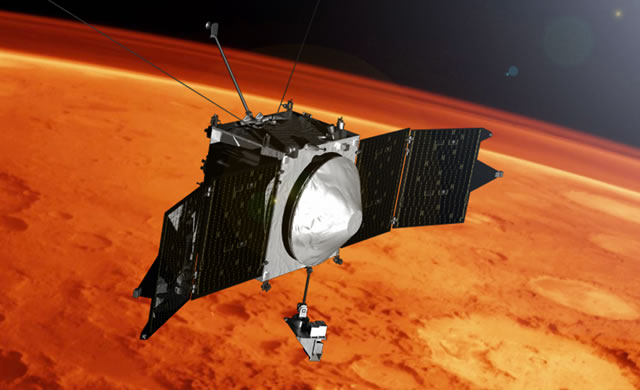
Credit: NASA’s Goddard Space Flight Center
Ecco i primi risultati delle misure raccolte dagli strumenti a bordo della sonda Mars Atmosphere and Volatile Evolution della NASA, grazie a cui comincia a delinearsi il complesso intreccio di interazioni tra il vento solare e l’atmosfera marziana.
Cominciano ad arrivare i primi risultati scientifici dalla sonda MAVEN della NASA, dedicata allo studio dell’atmosfera di Marte. Dopo essersi immessa nell’orbita del Pianeta rosso lo scorso settembre, avviato la fase di calibrazione dei suoi strumenti e aver pure superato senza problemi l’incontro ravvicinato con la cometa Siding Spring, MAVEN ha iniziato dal 16 novembre scorso a fare quello per cui è stata progettata: scienza di altissimo livello. Le prime analisi dei dati raccolti mettono subito in evidenza la presenza di un processo grazie al quale il vento solare riesce a penetrare negli strati più profondi dell’atmosfera marziana, contribuendo così alla sua depauperazione. «Stiamo iniziando a fare luce sulla catena di fenomeni che inducono la perdita di atmosfera su Marte» dice Bruce Jakosky, principal investigator di MAVEN. «Nel corso della missione riusciremo a ricostruire in dettaglio cosa avviene, ricostruendo come l’atmosfera di questo pianeta è cambinata nel tempo».
Fonte/Leggi tutto → Media.INAF.it
NASA’s MAVEN Mission Identifies Links in Chain Leading to Atmospheric Loss. Early discoveries by NASA’s newest Mars orbiter are starting to reveal key features about the loss of the planet’s atmosphere to space over time.
The findings are among the first returns from NASA’s Mars Atmosphere and Volatile Evolution (MAVEN) mission, which entered its science phase on Nov. 16. The observations reveal a new process by which the solar wind can penetrate deep into a planetary atmosphere. They include the first comprehensive measurements of the composition of Mars’ upper atmosphere and electrically charged ionosphere. The results also offer an unprecedented view of ions as they gain the energy that will lead to their to escape from the atmosphere. “We are beginning to see the links in a chain that begins with solar-driven processes acting on gas in the upper atmosphere and leads to atmospheric loss,” said Bruce Jakosky, MAVEN principal investigator with the Laboratory for Atmospheric and Space Physics at the University of Colorado, Boulder. “Over the course of the full mission, we’ll be able to fill in this picture and really understand the processes by which the atmosphere changed over time.”
Source/Continue reading → NASA.gov





















